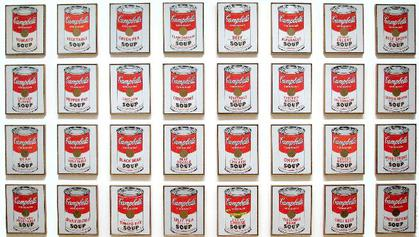The term “Postmodernism” is widely used to describe cultural changes to established structures and belief systems, often a direct retaliation against what is considered to be “modern” or the “modernist” movement that precedes the postmodernist movement. In the art world, postmodern art is a rejection of the idealism and utopian visions of the modern art movement. The term “postmodern ERP” was coined by Gartner in 2014 and represents, in its own way, the rejection of legacy or “modern” ERP that came before it. Originally, Gartner referred to this movement as, “the devolution of modern ERP,” but ultimately recognized the similarities between this “devolution” and the postmodernist art movement. Both art and technology, and thus ERP, are exercises in and expressions of human imagination.
As the Chief Creative Officer of Pixar, John Lasseter has said, “The art challenges the technology, and the technology inspires the art.”
From the late 1800s to the mid-1900s, the art world was dominated by a sense of progress, rational thought, technological advancement, optimism, and artistic purity (or elitism depending on who you asked). By the middle of the century, the art world, as well as the Western world in general, began to change. Two devastating world wars, communist ideology shattered and witnessing the devastation of nuclear weapons began to dim the optimism of the pre-war modernist movement. Eventually, the art world outright rebelled against modernism with a mindset that came to be known as postmodernism.
The Postmodern movement was comprised of many different artistic sub-categories (for example Pop Art, Minimalism, and Neo-Dada) and art forms (for example Video, performance, and installation in addition to traditional mediums like painting and sculpture). These movements were diverse and disparate but connected by certain characteristics.
Below are three postmodernist paintings that represent three major ideologies of the Postmodern Art movement that can be applied to Postmodern ERP.
Though The Treachery of Images (La trahison des images) was created by René Magritte about 40 years before the Postmodern Art movement, it greatly influenced the skepticism, Sinicism, and “question everything” philosophy of postmodern artists. It is a painting of a tobacco pipe with “Ceci n’est pas une pipe” below the image. This translates to “This is not a pipe.” This sentiment harkens to Korzybski’s general semantics premise of “The map is not the territory” or “The word is not the thing.”
When asked about the meaning of the piece, Magritte simply stated, “The famous pipe. How people reproached me for it! And yet, could you stuff my pipe? No, it’s just a representation, is it not? So if I had written on my picture ‘This is a pipe’, I’d have been lying!”

The Treachery of Images (aka This is not a Pipe) by René Magritte (source)
But how does this painting of a pipe relate to postmodern ERP? It questions preconceived notions.
ERP stands for Enterprise Resource Planning, and yet, with the adoption of Software-as-a-Service (SaaS) and cloud technology inherent in Postmodern ERP, small to mid-size businesses can afford the same robust solutions and functionality large enterprises have utilized for decades. So, Enterprise solutions are no longer exclusively for the Enterprise. The word is not the thing just as the painting is not the pipe.
Early in his career, Roy Lichtenstein committed one of the greatest sins an artist at that time could commit – he brought commercial art to the gallery. As one of the first great Pop artists, Lichtenstein drew inspiration from advertisements, comics, and everyday objects to convey his deadpan art style.
One of the central lessons of Pop art and Postmodernism is that all forms of communication are filtered through codes, language, and/or cognition. Where Magritte sought to explore the limitations of language (the word is not the thing), Lichtenstein sought to understand the code, or methodology of mechanical reproduction. He drew inspiration from mass produced images in comic books which were created by a printer using a series of Ben-Day dots in four process colors (cyan, magenta, yellow, and black). Deconstructing art to thick lines, dots, and these process colors, Lichtenstein was able to draw connections between low-brow, commercial art in comics and advertising and modern masterpieces. By challenging and deconstructing both beliefs and processes, Lichtenstein was able to revolutionize the art world and pave the way for Pop art and the postmodernist movement.

Sunrise by Roy Lichtenstein (Source)
How does this apply to postmodern ERP? Deconstruction leads to flexibility.
The days of buying one monolithic solution to meet all of a business’s needs with a few costly and time-consuming customizations are gone. However, in the postmodern ERP world, solutions are deconstructed into personalized sets of integrated business functions where the pieces make up the whole suite for each business. The goal is to use the best applications possible in each area of a business, while also ensuring that they integrate with each other as needed (either tightly integrated or very loosely coupled). Just as Lichtenstein deconstructed mass-produced images into Ben-Day dots and then reconstructed them into a masterpiece, the ERP suite has been deconstructed into applications that each business can tie together according to their individual needs.
Like Lichtenstein, Andy Warhol loved to question the differences between high and low culture by embracing consumerism and popular culture. Warhol asserted that all visual culture is equally valid and should be able to be appreciated without formal aesthetic training, thus undermining the modernist values of artistic worth – class, quality, and authenticity.
By interpreting such a well-known, seemingly commonplace subject matter as Campbell’s Soup, Warhol argued against the modernist idea of one inherent meaning to a work of art, or that the artist determined a piece’s meaning at the time of creation. Warhol was obsessed with the commonplace, famous, and popular icons because their visibility and accessibility meant that everyone had their own interactions with, and thus interpretation of these icons. This was reflected throughout his career in pieces like his Disaster series and Marilyn Monroe portraits.
To Warhol, Campbell’s Soup represented the monotony of his childhood, for better or worse. He said, “I used to drink it. I used to have the same lunch every day for 20 years, I guess, the same thing over and over again.” (Source) However, he made a point to leave no instructions on how to install the 32 separate pieces, each of a different variety of soup sold by Campbell’s at the time. The pieces were made using a combination of tracing, hand painting, and stamping. Warhol insisted that the viewer determined the meaning, based on their unique interactions and history with the subject matter, or even how they were presented from gallery to gallery. Some artists in the postmodernist movement took this sentiment a step further by allowing their audience to participate in performance art pieces or relying on the audience to create or complete the artwork altogether.

Campbell’s Soup Cans by Andy Warhol (Source)
Similarly to Warhol’s work, interpretation of a postmodern ERP strategy is unique to each business. There is no “one-size-fits-all” approach to postmodern ERP strategy.
Two organizations within the same industry could both implement strategies that are postmodern in nature and yet wildly different. That’s because each organization is different, and must define its own postmodern strategy according to its operations, unique needs, budget, and future goals.
Learn about how postmodern solutions are changing the debate between industry-specific and generic solutions.
For more information on Postmodern ERP and how it can benefit your business, download our free eBook!
Solutions by Industry
What's New
Outgrowing Your ERP? Why Acumatica is the Upgrade You Need
Read MoreSubmitted by Stephanie Dean on Thu, 06/26/25 - 15:52
Why You Should Make the Switch: NetSuite to Acumatica
Read MoreSubmitted by Stephanie Dean on Tue, 06/17/25 - 13:36
Acumatica ERP for Sustainable Businesses
Read MoreSubmitted by Stephanie Dean on Thu, 05/29/25 - 10:37